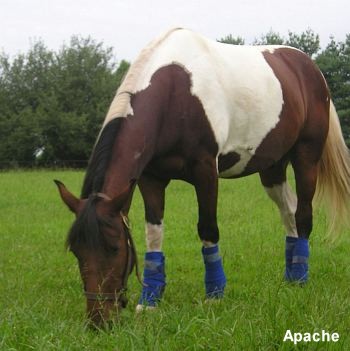
OVERVIEW
The Pinto horse is a color breed in contrast to most other breeds which are defined by their genetic ancestry. In America, the Pinto is regarded as a proper breed. Pintos have a dark background coloring and upon this color random patches of white. The Pinto coloration may occur in any breed or specific conformation. However, the Pinto Horse Assocation of America does not accept horses with Appaloosa, Draft, or mule breeding or characteristics. In the American west, the Pinto has traditionally been regarded as a horse the American Indian favored as a war horse since its coloring provided a natural camouflage.
PHYSICAL DESCRIPTION
The Pinto does not have consistent conformation since it is bred for color. When the darker color is black, the horse is often described as Piebald. When the darker color is anything but black, the horse is described as Skewbald. Pintos may be from a variety of breeds, ranging from Thoroughbred to Miniatures.
There are four acknowledged types of conformation however: the Saddle type, Stock type, Hunter type and Racing type. Type is determined by the conformation and background of each horse/pony. The STOCK TYPE Pinto is of predominanty Quarter and Paint breeding and conformation. The HUNTER TYPE Pinto is of predominantly Thoroughbred breeding and conformation. The PLEASURE TYPE Pinto is of predominantly Arabian or Morgan breeding and conformation. The SADDLE TYPE Pinto is American Saddlebred, Tennessee Walking or Missouri Foxtrotter breeding and conformation.
Pintos are also classified and registered according to their size. Animals maturing over 56" in height at the withers are horses. Ponies are animals 56" and under, but over 34". Any animals 34" and under at maturity is termed a miniature. B Miniature is a further classification for animals over 34" but not exceeding 38" at maturity. Each division, having its own rules and standards, allows for exhibition against "like" conformation and styles.
ORIGIN
Though commonly associated with the Native American for its legendary magical qualities in battle, the Pinto horse was actually introduced to North America by European explorers, chiefly those from Spain, bringing their Barb stock that had been crossed with native European stock years before. It is believed that the Pinto patterns may have arrived in Europe via the Arabian strains, as Pinto markings appear in ancient art throughout the Middle East. However, evidence of the more dominant Tobiano pattern among the wild horses of the Russian Steppes suggests the introduction of Pinto coloring to Europe possibly as early as during the Roman Empire.
After the arrival of these European horses, great wild herds infused with the flashy color patterns we know today began to develop across America, eventually to be domesticated by the Native American. The white man continued to import many of the well-established and stylish European breeds as his foundation stock. Over time, however, with the civilization of the Native American and the white man's migration to the frontier, it often became necessary to cross these fancy, but less suitable breeds of the Eastern seaboard with the wild mustang stock to increase size and attractiveness as well as availability of a horse better suited to the strenuous working conditions of the day. This Western-bred horse became a fixture of America, especially the uniquely marked Pinto whose colorful presence in parades and films always added a little extra glamour.
INTERESTING FACTS
What are the Pinto patterns and how do they differ? There are two recognized Pinto color patterns:
1) TOBIANO (Toe-bee-ah'-no) appears to be white with large spots of color, often overlapping on animals with a greater percentage of color than white. Spots of color typically originate from the head, chest, flank, and buttock, often including the tail. Legs are generally white, giving the appearance of a white horse with large or flowing spots of color. Generally, the white crosses the center of the back or topline of the horse. It is considered necessary to have a Tobiano parent to achieve a Tobiano foal.
2) OVERO(O-vair'-o) appears to be a colored horse with jagged white markings usually originating on the animal's side or belly, spreading toward the neck, tail, legs, and back. The color appears to frame the white spots. Thus, an Overo often has a dark tail, mane, legs, and backline. Bald or white faces often accompany the Overo pattern. Some Overos show white legs along with splashy white markings, seemingly comprised of round, lacy white spots. White almost never crosses the back or topline. A horse of Pinto coloration descendant from two solid colored parents of another typically solid colored pure breed is called a "crop-out" and is of the Overo pattern.
INFLUENCES
(See above Origin description)
For more information:
Pinto Horse Association of America
Page text from Oklahoma State University